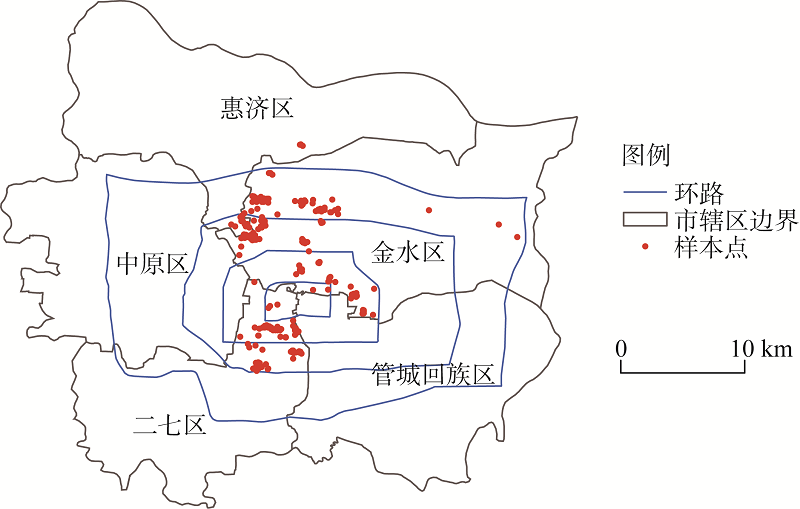

城市家庭食物消费差异的实证研究——以郑州市为例
|
侯鹏(1989- ),男,河南安阳人,博士研究生,研究方向为资源消费及其综合环境效应。E-mail: houp.17b@igsnrr.ac.cn |
收稿日期: 2020-01-15
修回日期: 2020-02-28
网络出版日期: 2021-10-28
基金资助
国家自然科学基金项目(41601602)
国家重点研发项目(2016YFE0113100)
版权
An empirical study of food consumption in urban households of Zhengzhou city
Received date: 2020-01-15
Revised date: 2020-02-28
Online published: 2021-10-28
Copyright
食物消费是人类最基本的消费行为。以中原地区典型城市郑州市为例,通过问卷调查和跟踪称重方法,获取了309户城市家庭的一手食物消费数据,定量分析了现阶段我国典型城市家庭食物消费的差异。研究表明:(1)郑州城市家庭人均食物消费总量为372.32 g/餐。其中,植物性食物的消费量约为动物性食物的3倍。(2)三个样本城区中,惠济区水产品和水果的人均消费量远低于金水区和二七区;收入水平较高的家庭,蔬菜、主食的人均消费量占人均食物消费总量的比例趋于减小,而水产品、奶类和水果的比例趋于增加;人口规模较小的家庭比规模较大的家庭人均食物消费量大。(3)通过与中国居民平衡膳食宝塔推荐的食物摄入量对比发现,郑州城市家庭主食类和蔬菜类消费量合理,畜禽肉和蛋类的消费量过高,粗杂粮、水果、奶类和大豆摄入不足。实证研究为进一步准确获取居民食物消费基础数据提供了参考,并为相关政策的制定提供了科学依据。

侯鹏 , 张丹 , 成升魁 . 城市家庭食物消费差异的实证研究——以郑州市为例[J]. 自然资源学报, 2021 , 36(8) : 1976 -1987 . DOI: 10.31497/zrzyxb.20210806
Food consumption is the primary way to get access to the basically-needed energy and nutrition for human being. Our investigation was conducted in Zhengzhou city, one of the provincial cities in central China, by a 3-consecutive-day household weighting survey. We gained a first-hand dataset consisting of 309 urban households in Zhengzhou and their food consumption data. Our research reveals that: (1) Urban households in the study city held a 372.32 g of food consumption for each meal per capita, which was dominated by plant-based foods (277.12 g). The ratio between plant-based foods and animal foods was 3∶1. (2) Among the three urban districts, Huiji consumed more sea food and fruits compared with Erqi and Jinshui. The per capita consumption of staple foods and vegetables for households in the city tended to decrease as annual per capita income rose, while that of fruits, seafood and dairy increased. Households with a smaller population consumed more food per capita compared with those with a larger population. (3) Furthermore, the comparison of research results and the general dietary guidelines indicated that the dietary pattern of urban households in Zhengzhou need to be further adjusted. Briefly, their meats consumption far exceeded the recommended upper threshold, while the consumption of dairy products and fruits did not reach the recommended anount. In the following application of "Health China" and other relevant national strategies, we should continue to highlight the urban household food consumption, promote and diversify the content and form of nutrition & health education in communities and families. The excessive meat consumption needs to be reduced in a reasonable range, and the high-nutrition foods should be expanded and encouraged.

Key words: food consumption; urban household; weighing method; Zhengzhou city
表1 中国居民平衡膳食宝塔与郑州城市家庭食物消费结构比较Table 1 Comparison of balanced diet pagoda of Chinese residents and food consumption structure of urban residents in Zhengzhou (g/d/人) |
| 食物类型 | 膳食宝塔推荐值[32] | 调研消费总量 | 调研正餐消费量 | 调研加餐消费量 |
|---|---|---|---|---|
| 谷薯类 | 250~400 | 295.00 | 290.57 | 4.43 |
| 蔬菜类 | 300~500 | 391.47 | 384.35 | 7.12 |
| 水果类 | 200~350 | 121.51 | 16.22 | 105.29 |
| 大豆及坚果类 | 25~35 | 14.52 | 11.72 | 2.80 |
| 畜禽肉 | 40~75 | 119.32 | 118.57 | 0.75 |
| 水产品 | 40~75 | 27.37 | 27.21 | 0.16 |
| 蛋类 | 40~50 | 62.83 | 62.47 | 0.36 |
| 奶及奶制品 | 300 | 76.08 | 50.36 | 25.72 |
| [1] |
李哲敏. 近50年中国居民食物消费与营养发展的变化特点. 资源科学, 2007, 29(1): 27-35.
[
|
| [2] |
曹志宏. 基于谷物当量的中国居民食物消费变化及其对农业生产需求分析. 资源科学, 2013, 35(11): 2181-2187.
[
|
| [3] |
高晶, 唐增. 基于食物当量的中国居民食物消费变化. 中国食物与营养, 2018, 24(2): 63-67.
[
|
| [4] |
|
| [5] |
|
| [6] |
方精云. 我国草原牧区呼唤新的草业发展模式. 科学通报, 2016, 61(2): 137-138.
[
|
| [7] |
谢高地, 成升魁, 肖玉, 等. 新时期中国粮食供需平衡态势及粮食安全观的重构. 自然资源学报, 2017, 32(6): 895-903.
[
|
| [8] |
成升魁, 汪寿阳. 新时期粮食安全观与粮食供给侧改革. 中国科学院院刊, 2017, 32(10): 1074-1082.
[
|
| [9] |
|
| [10] |
|
| [11] |
辛良杰, 王佳月, 王立新. 基于居民膳食结构演变的中国粮食需求量研究. 资源科学, 2015, 37(7): 1347-1356.
[
|
| [12] |
周琳, 杨祯妮, 程广燕, 等. 我国居民食物消费主要特征与问题分析. 中国食物与营养, 2016, 22(3): 47-51.
[
|
| [13] |
熊靓, 王东阳. 居民食物消费特征及影响因素分析: 基于全国20省居民食物消费调研. 中国食物与营养, 2017, 23(3): 49-53.
[
|
| [14] |
|
| [15] |
|
| [16] |
|
| [17] |
熊欣, 张力小, 张鹏鹏, 等. 城市食物代谢的动态过程及其水—碳足迹响应: 以北京市为例. 自然资源学报, 2018, 33(11): 1886-1896.
[
|
| [18] |
董佳静, 赵旸, 王重阳, 等. 1980—2016年北京市食物消费的土地需求. 资源科学, 2019, 41(7): 1350-1358.
[
|
| [19] |
|
| [20] |
|
| [21] |
张印午, 曹雅璇, 林万龙. 中国城乡居民口粮消费差距估算: 基于中国健康与营养调查数据. 西北农林科技大学学报: 社会科学版, 2012, 12(4): 50-56.
[
|
| [22] |
辛良杰, 李鹏辉. 基于CHNS的中国城乡居民的食品消费特征: 兼与国家统计局数据对比. 自然资源学报, 2018, 33(1): 75-84.
[
|
| [23] |
叶予舜. 各种食物制备前后成品重量增损比率表. http://wenku.baidu.com/view/dec4ab1414791711cc7917dd.html 2015-03-30.
[
|
| [24] |
杨月欣, 王光亚, 潘兴昌. 中国食物成分表(第二版). 北京: 北京大学医学出版社, 2009: 4-173.
[
|
| [25] |
|
| [26] |
|
| [27] |
|
| [28] |
崔姹, 王明利. 中国肉类消费发展分析及未来展望. 农业展望, 2016, (10): 74-80.
[
|
| [29] |
黄季焜. 社会发展, 城市化和食物消费. 中国社会科学, 1999, (4): 106-116, 206.
[
|
| [30] |
韩啸, 齐皓天, 王兴华. 收入对城镇居民食物消费模式影响研究: 基于两阶段EASI模型估计. 北京航空航天大学学报: 社会科学版, 2019, 32(2): 92-98.
[
|
| [31] |
韩秀兰. 中国居民家庭消费的规模经济性研究. 统计与决策, 2017, (7): 143-145.
[
|
| [32] |
中国营养学会. 中国居民膳食指南(2016). http://dg.cnsoc.org/article/04/8a2389fd5520b4f30155be1475e02741.html 2020-02-19.
[Chinese Nutrition Society. Chinese dietary guide (2016). http://dg.cnsoc.org/article/04/8a2389fd5520b4f30155be1475e02741.html 2020-02-19.]
|
| [33] |
郑州市统计局, 国家统计局郑州调查队. 2018郑州统计年鉴. 北京: 中国统计出版社, 2018: 204-205.
[Statistics Bureau of Zhengzhou City, The National Bureau of Zhengzhou Investigation Team. Zhengzhou Statistical Yearbook (2018). Beijing: China Statistics Press, 2018: 204-205.]
|
/
| 〈 |
|
〉 |